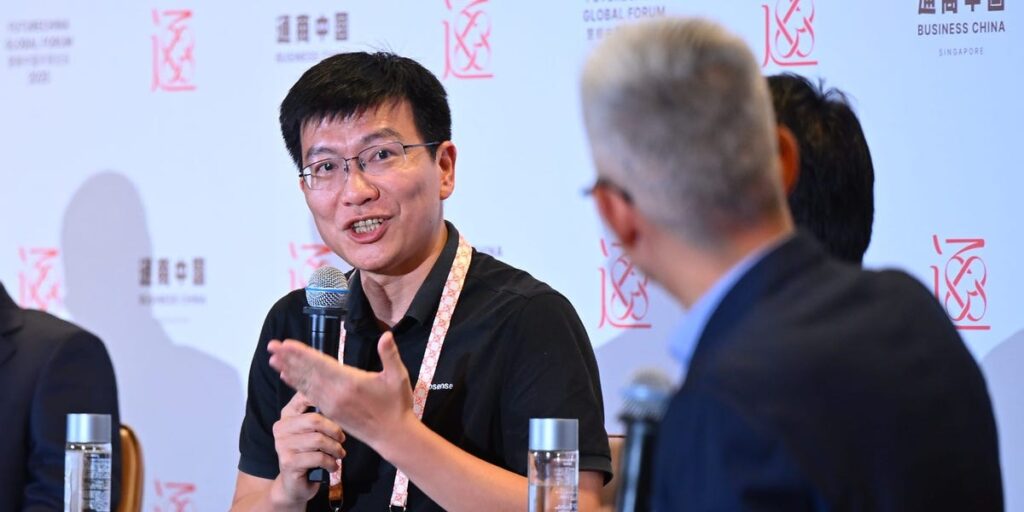Steven Qiu, the founder of Chinese LiDAR maker RoboSense, says a multi-sensor system is a better and safer approach for self-driving vehicles than the vision-only system touted by Tesla CEO Elon Musk.
LiDAR, which stands for Light Detection and Ranging, is a sensor that scans the environment by emitting laser beams and measuring the time it takes to get a return signal. LiDAR can be found in Waymo’s robotaxis and consumer products, like robot vacuums and smartphone cameras.
“There’s been a lot of debate over whether a vision-only or multi-sensor approach is better when it comes to self-driving vehicles in the past 10 years or so,” Qiu told Business Insider on the sidelines of the FutureChina Global Forum held in Singapore in September.
“But by now, it is clear that everyone understands that a vision-only approach is not safe enough. There are a lot of corner cases that a vision-only system cannot account for,” he added.
Qiu told Business Insider that vehicles would not be able to achieve Level 3 or Level 4 driving automation capability with a vision-only system. He added that other sensors, including LiDAR, need to be added to the mix to do so.
The standards organization SAE International ranks automation systems from Level 1 to 5. Level 1 systems can only provide basic assistance, like automatic braking and lane-keeping, while Level 5 systems can drive a vehicle in all conditions. Tesla’s Full Self-Driving software requires human supervision and is a Level 2 system.
“Let’s say you are cruising on an expressway. If there is a white car that has stopped in front of you, it would be challenging for a vision-only system to tell if it’s a car or a white cloud in the sky,” Qiu said.
“Similarly, if you are driving toward a tunnel, the system may not be able to tell if there’s a black car driving ahead of you,” he added.
RoboSense, founded in 2014, had the world’s largest market share for passenger car LiDAR systems in 2024, market research group Yole Group said in a report published in March.
Musk: LiDAR is ‘expensive and unnecessary’
Musk has long been a critic of LiDAR systems, including as recently as August. In April 2019, Musk said at Tesla’s “Autonomy Day” event that automakers will eventually stop using LiDAR technology on their self-driving vehicles.
“I should point out that I don’t actually super hate LiDAR as much as it may sound,” Musk said, adding that SpaceX’s Dragon spacecraft uses LiDAR to navigate and dock at the International Space Station.
“In cars, it’s friggin stupid. It’s expensive and unnecessary,” he continued. “Once you solve vision, it’s worthless. So you have expensive hardware that’s worthless on the car.”
Qiu said that the cost of LiDAR systems has fallen significantly in the past few years, from about $70,000 per vehicle to around a few hundred dollars. He added that the performance capabilities of LiDAR systems have also increased as their cost continues to decline.
Musk’s views on LiDAR appear to be in the minority among auto executives. Ford CEO Jim Farley said at the Aspen Ideas Festival in June that his company views LiDAR as “mission critical.”
“For example, a reflection on the back of a truck or the sun in the camera’s eyes where the camera will be completely blinded, the LiDAR system will see exactly,” Farley said.
Li Xiang, the CEO of Chinese EV maker Li Auto, said at his company’s “AI Talk” event last year that Musk cannot see the value of LiDAR because American and Chinese traffic conditions are vastly different.
“If you drive in China at night, you will often see trucks with broken tailights, or even trucks without working tailights, just parked on the road,” he said, adding that existing camera systems would not be able to detect these trucks from afar.
“I believe that if Musk were in China, and driving on various highways late in the night, he would choose to include LiDAR as well,” he added.
Read the full article here


